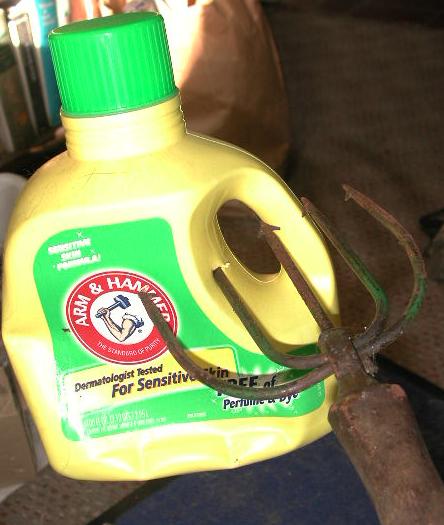| 02-24-03
Stop! Don't stash those guns, bows and other outdoors paraphernalia
in some dark old closet.
Oh! I know, the hunting seasons have ended--or are about to do so--and
the fishing is somewhere in the future, the nearer the better.
But keep that stuff handy. You may be able to use it for something
besides hunting, fishing and other legitimate pursuits. You may become
somebody's hero.
Take, for example, a problem that cropped up at our house a few weeks
back when an empty plastic laundry soap container (sort-of a bottle) fell
off the washing machine behind the little folding door which closes off
the closet-like area where the stacked washer-dryer spend their time.
With the bottle perched on the floor at the joint of the folding door
and wedged against the washing machine, nothing would move either way.
I couldn't open the door more, nor could I close it.
"Looks like the door will have to be removed," my wife said, telling
me about the plight of the plastic bottle.
"Not if I can help it," I said, remembering the last time I ineptly
tangled with that door. "Let me think about it."
Think about it, I did--but only for a few minutes. I marched into my
workroom (also called "the den" when I am in a jocular mood) to pull my
flounder gig (spear) out of its hiding place, and went back to the troubled
closet.
The flounder gig has five sharply-pointed tines of strong steel that
are roughly five inches long, each with a strong barb. The head is about
five inches wide and it is mounted on a strong handle about four feet long.
 The
head of the jig is a little goggle-eyed from being jabbed into the sandy
bottom of Pamlico Sound on North Carolina's famed Outer Banks. But it still
is strong. The
head of the jig is a little goggle-eyed from being jabbed into the sandy
bottom of Pamlico Sound on North Carolina's famed Outer Banks. But it still
is strong.
Easing the handle around the half-open door and allowing the gig head
to rest against the belly of the plastic bottle, I had only to raise it
slightly and thrust it downward with a little force to penetrate the bottle.
With the barbs of two tines inside the bottle, I had only to fish it
out and close the door.
Easy game, Coach!
I don't know how many times I have used my outdoor equipment to achieve
other mundane goals, but the possibilities are endless.
One summer day I saw my neighbor on top of his house trying to throw
a rope over the limb of a sycamore tree, that had broken, but not enough
to fall.
What he wanted to do was throw one rope over a stronger, unbroken limb,
then attach the end of the rope with a slipknot to the broken limb. He
explained that with this setup he could raise and lower the broken limb
until it would separate from the tree, then lower it slowly to avoid damage
to his roof.
But he couldn't get the rope over either limb.
"I can do it," I told him. "I'll get my fishing rod."
Back on the roof with my neighbor, I tied a quarter-ounce bell sinker
on my line, and flipped it over the high limb, allowing the sinker to pull
the 15-pound-test line back down to the spot where we stood.
I cut off the sinker, tied on the light, but strong rope and pulled
it over the top limb and down.
Then with the sinker tied on my fishing line again, I flipped it over
the lower limb on the first cast.
By pulling down extra belly in the line, we fashioned a slipknot and
pulled it taut on the lower (broken) limb.
My neighbor thought by pulling the broken limb (about 2-to-3 inches
in diameter) up and down the broken place would sever and we could lower
it softly to the roof.
There we encountered trouble. The broken place on the limb was stronger
than we thought. The limb would not fall, and now we had this problem of
getting the rope off the limb.
My chain saw would have solved the problem quickly, but the limb was
far too high and dangerous to even consider that.
My three-inch magnum Remington Model 1100 duck gun came to the rescue.
With a three-inch maggie load of No. 4 lead shot (this was before the lead
shot ban) in the chamber, I took dead aim on the weak point of the limb
and touched it off.
Bullseye! The limb didn't fall, but it was weaker, and a second shot
severed it. Paying out line, my neighbor brought it down slowly by allowing
the rope to slide through his gloved hands.
Over the years I have used my long-handled landing net to humanely
capture everything from house cats to great-horned owls that needed help
(but didn't want it), my ice spud to loosen crusted snow and ice from walkways,
and a variety of other outdoor stuff to do indoor jobs.
It is great off-season fun.
|

